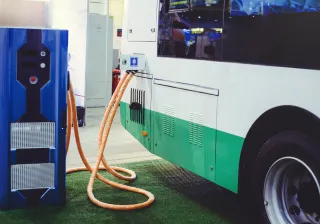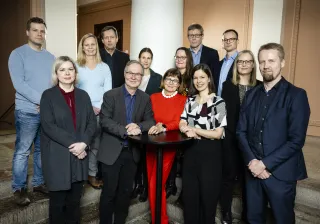We are currently witnessing a real shift towards zero-emission and carbon-neutral transport. In certain sectors it is already in full swing, whereas in other fields of transport and logistics it is only just beginning.
Biogas is emerging as a new renewable fuel alternative especially in heavy transport. In the coming years, the rapidly expanding and commercially competitive renewable electricity production will probably offer growing volumes of green hydrogen for industrial processes and for transport use as well. In Norway, rechargeable hybrid and fully electric vehicles accounted for around 80% of the market of new passenger cars in the first quarter of the year. In Finland, rechargeable vehicles are expected to become the bestselling vehicle category by the end of the year. It is also about time for me personally to upgrade an aged internal combustion engine car to a more modern alternative.
Breakthrough in battery technology and electric vehicles
All key technologies needed for electronic transport were originally invented in the 19th century. Rechargeable batteries, fuel cells, electric motors and AC-DC converters have all evolved significantly over the past decades and centuries. Even the first electric vehicles saw the light of day well before the end of the 19th century, and the first electric vehicle was brought to serial production in the early 20th century. However, the 20th century turned into the golden age of fossil fuels largely because the properties of electrical components, especially batteries that serve as energy storage, were not sufficient for the motoring needs.
The path towards a real breakthrough in energy storage began in the 1970s and 1980s, when Stanley Whittingham, John Goodenough and Akira Yoshino each made their own inventions that led to the development of the current lithium-ion battery. Before the turn of the millennium, we had already become familiar with such new applications using these batteries as mobile phones, laptops and other entertainment electronics. In recognition of their inventions, the three researchers mentioned above shared the Nobel Prize in Chemistry in 2019.
Over the recent years, a return to the roots of automotive technology, i.e., from combustion engines to electric vehicles, has taken place. From around 2010, many remember the first electric car manufactured in Uusikaupunki, Think City. The market response to one of the first attempts to launch an electric car that would appeal to the masses was mainly sympathy. The technology was not quite mature enough or the time was not ripe for the launch. Tesla hit the jackpot only a few years later, albeit in the premium market segment. When celebrating the Nobel Prize in 2019, it could be concluded that Tesla held both the technical and market lead, which others are still trying to catch up with. Electric vehicles are becoming more common in lower price categories and, in many regions, they have found their way among the vehicles purchased by companies and used by them for commercial purposes. This development has also been successfully supported by various steering and supportive measures in countries leading the market shift and in Finland as well.
Electrification of commercial transport in urban areas increasing
Around 2012, VTT launched its first trials with commercially available electric buses in urban transport in collaboration with Helsinki Regional Transport Authority (HSL) and Veolia (currently Transdev). The teething troubles in the first products showed that the technology was not yet ready at the time. We also soon discovered that, when it came to commercially operated transport, the need to regard transport electrification as a system solution became strongly emphasised. As the energy chain changes, the entire system and the implementation of charging and operations must be taken into account in acquisitions, planning and implementation from the outset, so that the infrastructure supports the productive use of vehicles as cost-effectively and reliably as possible. A great deal has happened in a decade, in the regulatory framework as well, where European requirements are steering both manufacturers and suppliers towards cleaner transport. A significant share of the competitive biddings arranged by HSL's bus transport are currently won by electric buses. The fact that electric buses are winning a greater than minimum required share of the latest contacts shows that electric buses are commercially viable within the framework of the tenders. The International Association of Public Transport (UITP) coordinates the European Commission's Clean Bus Deployment Initiative.
However, in the big picture, the change is only just beginning.
In urban areas, commercial vehicles, refuse collection, urban freight and logistics have reached the point in which the electric city buses were about six years ago: The first operators and suppliers are trying out electric lorries or refuse trucks, purchasing equipment from a limited market. Pre-series products are expensive and difficult to obtain to Finland. Other reasons for the slower development in urban distribution vehicles and refuse trucks compared to urban buses include their more diverse uses, operative constraints and more varying performance requirements.
On the other hand, in recent years the development has been accelerated by major advances made in battery systems, powertrainsfor heavy vehicles and charging solutions – the supply and cost competitiveness of electric vehicles are expected to improve rapidly. In towns, cities and built environments, the infrastructure needs for charging can often be solved as long as the towns and cities take part in the change – preferably in the driver's seat. Furthermore, in terms of regulation, the actions of both manufacturers and public sector suppliers are accelerated by the Clean Vehicles Directive and the mandatory emission requirements on vehicle manufacturers. Based on the experiences of the electrification of passenger vehicles and urban buses, over the next five years we can expect a significant shift in the direction of electrification in urban commercial vehicles from vans to lorries and, in part, in working machinery as well.
Challenges in mobile working machinery and heavy road transport
Things remaining in the future part of our journey in time include not only the vehicles and uses described above, but also a significant share of the transport sector's energy use, and kilometrage and haulage in heavy transport. The raw material, goods and value flows of industrial and commercial transport, as well as publicly procured road transport constitute a heterogeneous group of operators which have a wide variety of vehicles with varying uses and opportunities for introducing alternative fuels, such as gas, hydrogen or electricity, and for building infrastructure. In Finland, so far, this field of operations has not been studied very systematically.
Road transport statistics give useful insights into operations and zero-emission potential in areas such as regional distribution, long-distance transport, and transport of timber, wood products and soil. Gas and biogas may quite rapidly offer a new good alternative as driving power for demanding areas of transport in Finland. As far as electrification is concerned, many technology solutions are only about to become available, and additional planning and analysis is needed for an appropriate charging infrastructures that can serve the needs of different users. Based on statistics, there are uses even in the heaviest road transport in which the average length of the journey or the haulage frequency may well enable zero emissions through electrification. In addition to road vehicles, various types of mobile machinery used in urban areas, agriculture, forestry and industry are relevant for the zero-emission path.
In the pursuit of an acceptable, energy-efficient and carbon-neutral or zero-emission system with a competitive cost structure in the transport sector, the greatest challenges, or opportunities, of this decade are found in the field of trucks and lorries, commercial transport, road transport and mobile machinery. The most viable carbon-free or zero emission system solution, including the necessary alternative fuels infrastructure, needs to be one which does not disrupt the actual transport process itself – of course, it is necessary to develop the processes at the same time. Enterprises and public sector suppliers must be sufficiently familiar with innovative solutions and alternatives up to the transport system level and build trust in new technologies based on experience. The strategic choices made in transport and energy infrastructures must support the transport-sector shift in a cost-effective and timely manner. Regulations and policy measures can be used for launching and accelerating the green transition in the transport sector, speeding up our journey in time towards a market-based shift to zero emissions. All viable solutions should be implemented in a well-considered manner.
The blog is an outcome of research project KAROLIINA funded by the Finnish Prime Minister's Office, implemented by VTT and VATT. The project studied the role of vehicles and machinery acquired by companies in the climate policy of the emissions burden sharing sector. The final project report (in Finnish) was published on 12 May 2021.








